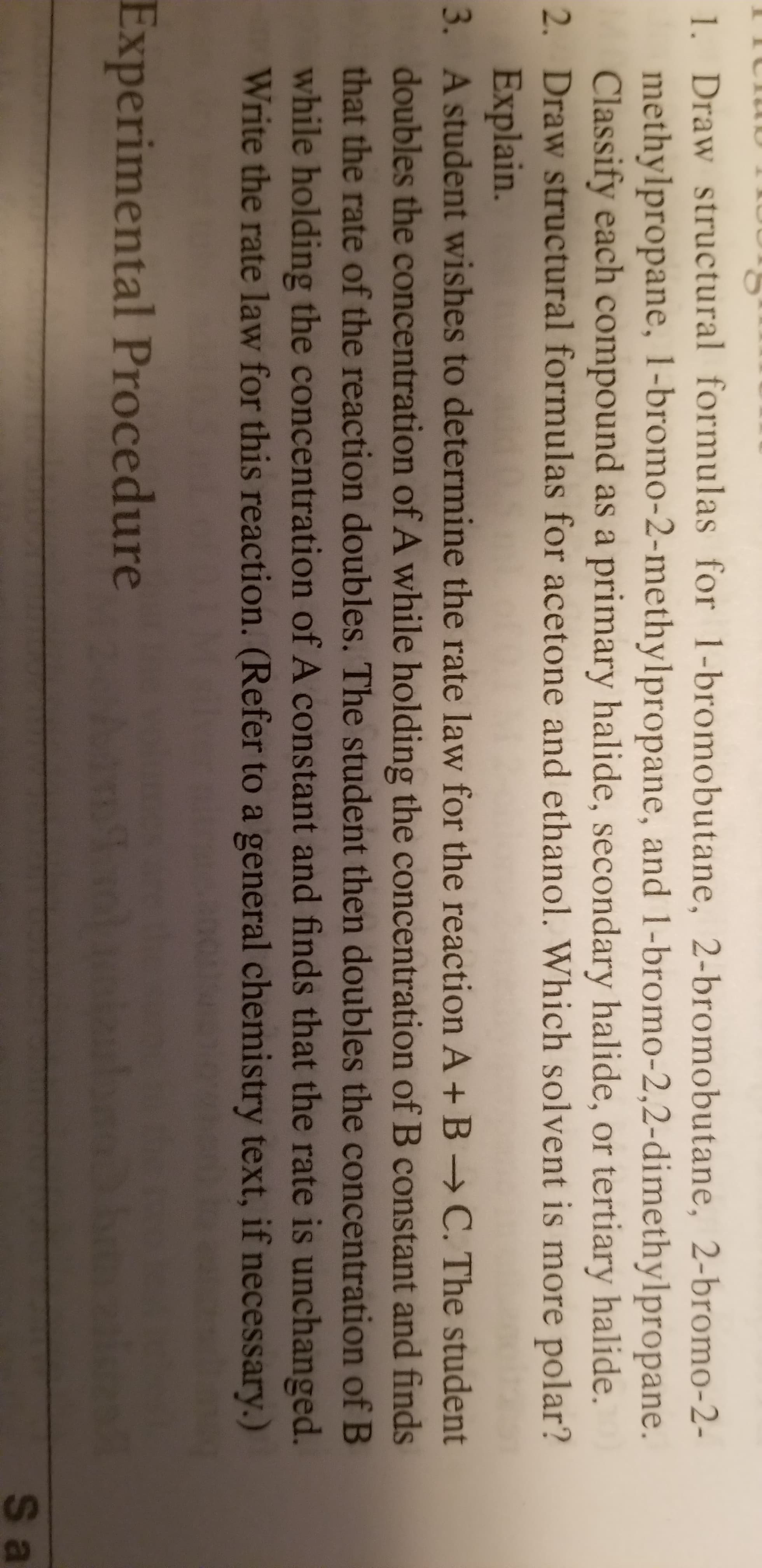1. Draw structural formulas for 1-bromobutane, 2-bromobutane, 2-bromo-2- methylpropane, 1-bromo-2-methylpropane, and 1-bromo-2,2-dimethylpropane. Classify each compound as a primary halide, secondary halide, or tertiary halide. 2. Draw structural formulas for acetone and ethanol. Which solvent is more polar? Explain. 3. A student wishes to determine the rate law for the reaction A +B → C. The student doubles the concentration of A while holding the concentration of B constant and finds that the rate of the reaction doubles. The student then doubles the concentration of B while holding the concentration of A constant and finds that the rate is unchanged. Write the rate law for this reaction. (Refer to a general chemistry text, if necessary.) Experimental Procedure S a
1. Draw structural formulas for 1-bromobutane, 2-bromobutane, 2-bromo-2- methylpropane, 1-bromo-2-methylpropane, and 1-bromo-2,2-dimethylpropane. Classify each compound as a primary halide, secondary halide, or tertiary halide. 2. Draw structural formulas for acetone and ethanol. Which solvent is more polar? Explain. 3. A student wishes to determine the rate law for the reaction A +B → C. The student doubles the concentration of A while holding the concentration of B constant and finds that the rate of the reaction doubles. The student then doubles the concentration of B while holding the concentration of A constant and finds that the rate is unchanged. Write the rate law for this reaction. (Refer to a general chemistry text, if necessary.) Experimental Procedure S a
Macroscale and Microscale Organic Experiments
7th Edition
ISBN:9781305577190
Author:Kenneth L. Williamson, Katherine M. Masters
Publisher:Kenneth L. Williamson, Katherine M. Masters
Chapter52: Hexaphenylbenzene And Dimethyl Tetraphenylphthalate
Section: Chapter Questions
Problem 1Q
Related questions
Question

Transcribed Image Text:1. Draw structural formulas for 1-bromobutane, 2-bromobutane, 2-bromo-2-
methylpropane, 1-bromo-2-methylpropane, and 1-bromo-2,2-dimethylpropane.
Classify each compound as a primary halide, secondary halide, or tertiary halide.
2. Draw structural formulas for acetone and ethanol. Which solvent is more polar?
Explain.
3. A student wishes to determine the rate law for the reaction A +B → C. The student
doubles the concentration of A while holding the concentration of B constant and finds
that the rate of the reaction doubles. The student then doubles the concentration of B
while holding the concentration of A constant and finds that the rate is unchanged.
Write the rate law for this reaction. (Refer to a general chemistry text, if necessary.)
Experimental Procedure
S a
Expert Solution
This question has been solved!
Explore an expertly crafted, step-by-step solution for a thorough understanding of key concepts.
This is a popular solution!
Trending now
This is a popular solution!
Step by step
Solved in 4 steps with 4 images

Recommended textbooks for you

Macroscale and Microscale Organic Experiments
Chemistry
ISBN:
9781305577190
Author:
Kenneth L. Williamson, Katherine M. Masters
Publisher:
Brooks Cole

Macroscale and Microscale Organic Experiments
Chemistry
ISBN:
9781305577190
Author:
Kenneth L. Williamson, Katherine M. Masters
Publisher:
Brooks Cole